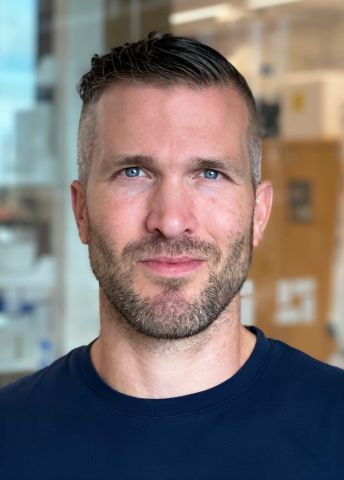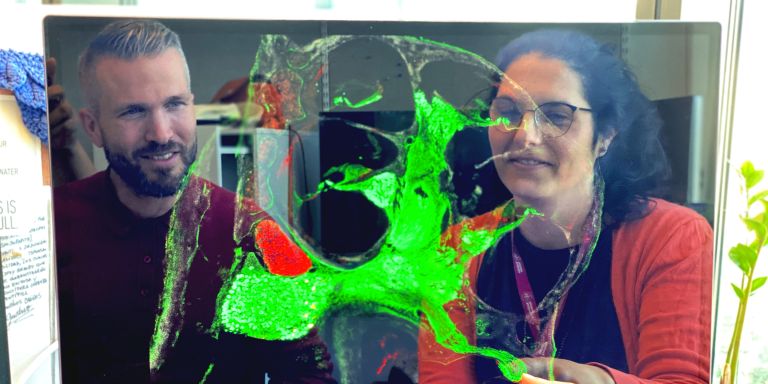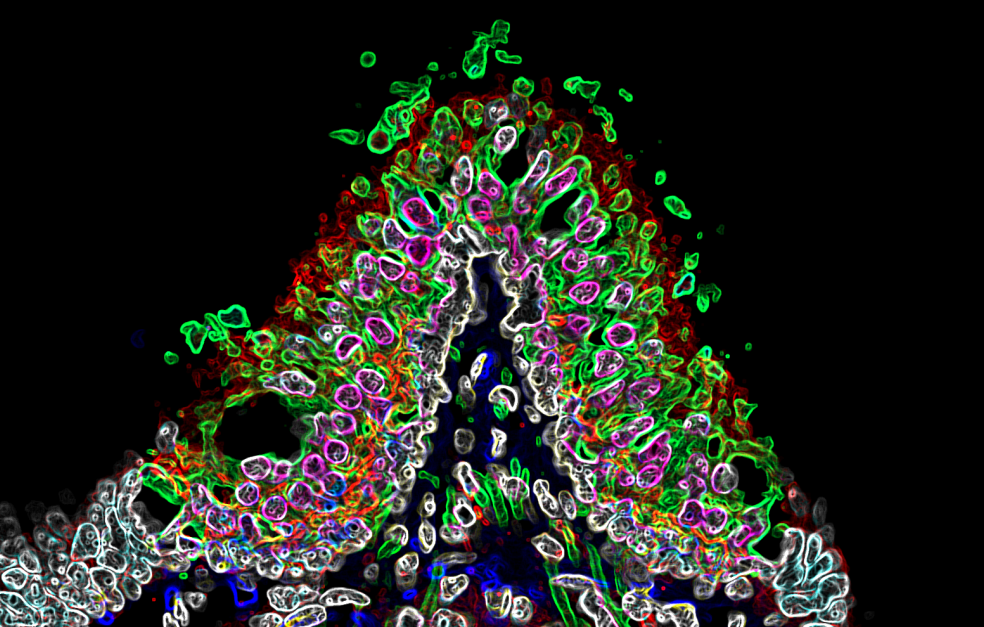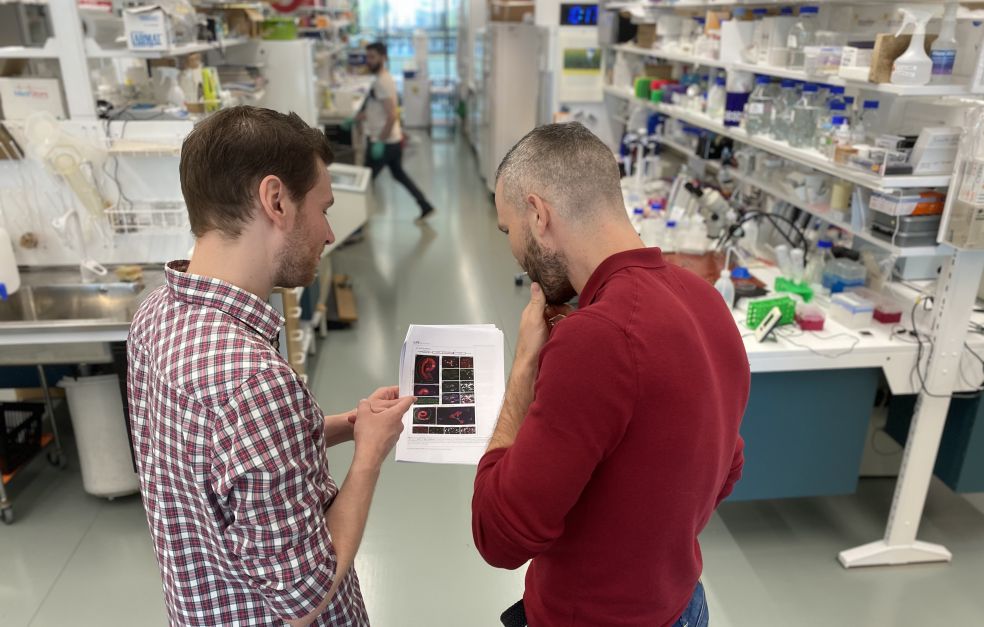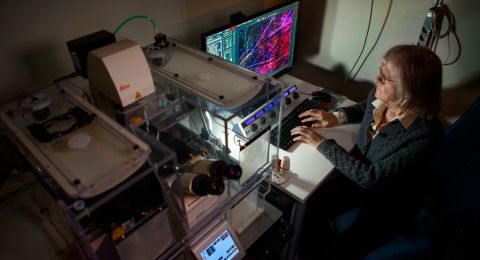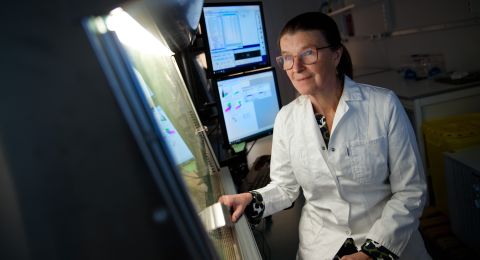It is well known that the brain is plastic and adaptable. François Lallemend is investigating whether plasticity also exists outside the brain, in the peripheral nervous system. Among other things, he is studying neurons in the inner ear and in the central auditory system. He hopes his research will eventually contribute to new genetic tools for treatment of hearing damage and other conditions.
François Lallemend
Associate Professor of Neurobiology
Wallenberg Academy Fellow, prolongation grant 2018
Institution:
Karolinska Institutet
Research field:
Molecular mechanisms regulating the development and function of the peripheral nervous system
On the wall of Lallemend’s office hangs a magnified and colorful microscope image of the branching nervous system in a mouse paw.
“It’s a paw from a mouse embryo,” he explains.
Lallemend’s research team is studying the peripheral nervous system. This is the part of the nervous system that includes everything except the brain and spinal cord (see fact box). In the laboratory at Karolinska Institutet in Solna, north of Stockholm, the team is examining sensory neurons from mice to learn more about molecular and genetic differences.
“The peripheral nervous system is much more complex than we thought. My research team is amongst others studying neurons in the auditory system and the proprioceptive system, which concerns body awareness and muscle control. When we found out there were more cell types than we thought, we suddenly realized that ‘ah – maybe they’re plastic’; maybe they change identity. We want to study this in further detail.”
Plasticity means that the system is flexible and capable of adapting. Lallemend explains that plasticity has traditionally been seen purely from the perspective of the central nervous system. It plays a key role in development and function of the brain and spinal cord. This is how we learn a new instrument, language, or new movements. The adaptation can be retained for years.
“The idea that there may be plasticity also in the peripheral nervous system is exciting. The only plasticity that has been demonstrated there is linked to pathological changes, such as pain. But that is not considered plasticity for adaptation and learning. I think we should be open to the idea of exploring plasticity in the peripheral nervous system. We want to study this, both in a pathological context, such as hearing impairment, and a non-pathological one, like motor performance.”
Depending on what their studies reveal, Lallemend wants eventually to apply the knowledge to humans. He hopes his research will contribute to future genetic approaches, potentially capable of reversing pathological changes relating to conditions such as impaired hearing.
Exploring neurons in depth
The research team is studying multiple aspects of the peripheral nervous system. In addition to the inner ear, hearing, and the proprioceptive system, they are examining the molecular development of sensory neuron and the vestibular system (the balance system in the inner ear).
“There are many similarities, so what we learn about the proprioceptive system we can also use for hearing, and what we use there can be translated to the vestibular system.”
Thanks to a technique called single-cell RNA sequencing, it is now possible to obtain detailed genetic information about individual cells. Lallemend’s team is combining this technique with other methods to penetrate deep into neurons to carry out analyses and identify minute differences.
“We then want to understand whether those differences are significant, whether they represent different states of the same cell type, or whether they are different cell types or subtypes. That knowledge will be used to analyze the function and anatomy of the cell types to determine which neural circuits they are connected to in the system and the specific sensory function they play.”
“I feel that the Foundation has faith in my research and realizes that what I’m doing may benefit the research field if I succeed. The great thing about the Fellow grant is that it gives you a big push – ‘Get started and give it a try’. You can take the risk of really trying and hope that something good will come of it.”
A patient adventure
The project that Lallemend is heading as a Wallenberg Academy Fellow will now focus on the inner ear. They are starting in the periphery of the auditory system, but also want to find out what happens after that.
“All this neuronal complexity must be translated somewhere, and the first stage after the inner ear is the brain stem, located between the brain and the spinal cord. It not only receives information from the auditory system; it joins it up with information from other sensory and non-sensory systems, functioning as an enormous multisensory center, which we want to understand better.”
Lallemend does not believe that plasticity plays a major part in the auditory system.
“The ear requires a system that is very sensitive but stable. There is no obvious need to change it. But I think there is some kind of plasticity there that we don’t understand, one that may be the origin of pathology such as hearing impairment. In the proprioceptive system on the other hand, plasticity may be present for adaptation to meet our motor requirements. This is something we want to look into – to find out whether plasticity exists and if so, for what purpose.”
Lallemend is happiest when research feels like an adventure and prefers to pursue ideas that are a little less certain.
“For me it’s about curiosity and suddenly discovering the unexpected. And then seeing whether I’m on the right track, finding new pieces in the puzzle and putting them together. That’s why I’m so interested in plasticity – it was something quite new that I hadn’t expected. But patience is needed because everything takes a long time.”
Text Susanne Rosén
Translation Maxwell Arding
Photo Saida Hadjab, Paula Fontanet
